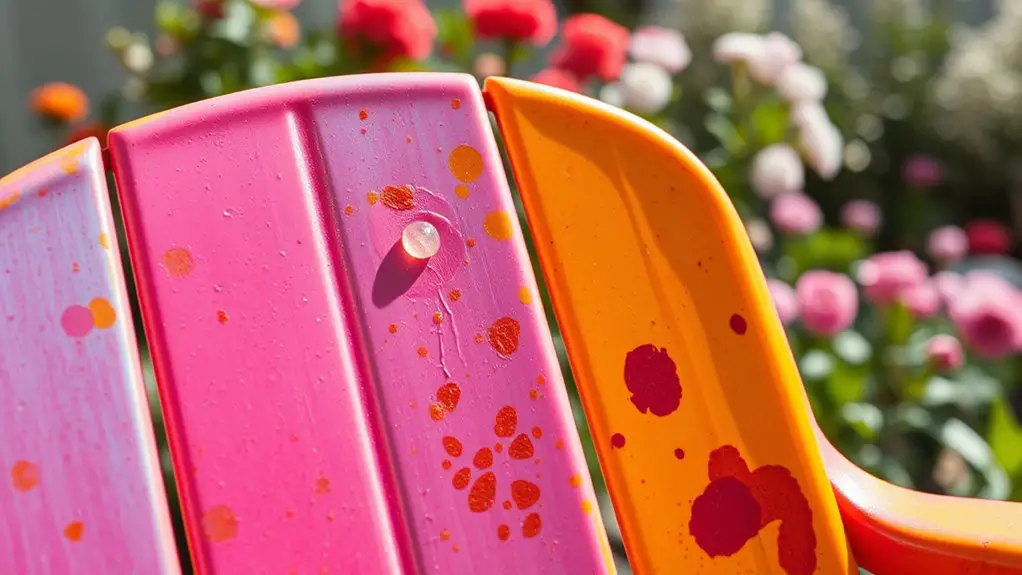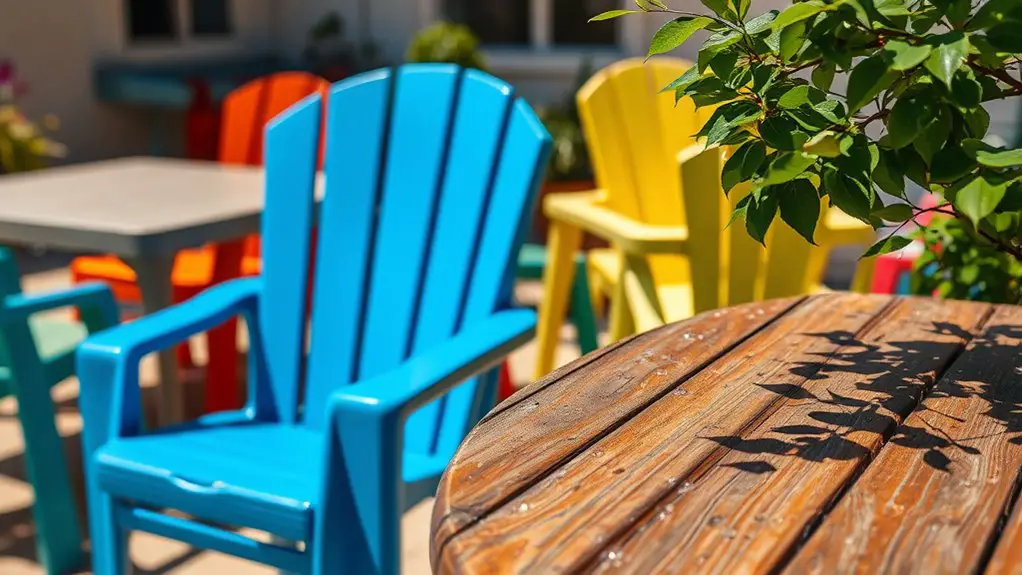Plastic furniture is often considered low-maintenance, but it does need some attention to stay in great shape. You can easily clean it with a mild soap solution and a soft cloth. Avoid harsh chemicals and abrasive materials, as these can cause damage. Regular dusting is essential, along with occasional deep cleaning using vinegar or baking soda to tackle stubborn stains. Protect your furniture from the elements and store it properly during off-seasons for longer life. With a little effort, you'll keep your plastic pieces looking vibrant. There's more insight into maintaining your furniture effectively if you explore further.
Key Takeaways
- Plastic furniture requires regular cleaning with mild soap and water to maintain its appearance and integrity.
- Avoid harsh chemicals and abrasives to prevent damage and discoloration of the plastic surface.
- Seasonal maintenance, including protective coatings, helps prevent chalky build-up and prolongs the furniture's lifespan.
- Proper storage and covering during extreme weather conditions are essential for protecting plastic furniture from damage.
- While generally low-maintenance, addressing stubborn stains promptly ensures the furniture remains visually appealing and functional.
Cleaning Methods for Plastic Furniture
When it comes to cleaning plastic furniture, you've got several effective methods at your disposal. Start with a simple mixture of a few drops of mild dish soap in a bucket of warm water. Use a soft cloth or sponge to gently wipe the furniture, then rinse it with clean water to remove any soap residue. To prevent water spots, dry the furniture with a towel afterward.
For tougher stains, mix 1/4 cup of bleach with a gallon of warm water. Make sure to wear protective rubber gloves, and use a scrub brush to clean the furniture. Rinse thoroughly with a power hose. If you're working with colored plastic, don't let the bleach sit too long to avoid fading. By choosing HDPE furniture, you can contribute to a more sustainable and eco-friendly cleaning routine.
Natural cleaning agents like white vinegar can also work wonders. Combine 1/4 cup of vinegar with warm water for general cleaning, or use an equal-parts solution to combat mildew. For stubborn stains, create a baking soda paste and let it sit for 15 minutes before scrubbing. Regular cleaning helps to prolong the lifespan of plastic furniture, ensuring it remains functional and aesthetically pleasing.
Lastly, specialized cleaning solutions like laundry detergent or melamine sponges can help you tackle those tough spots efficiently.
Avoiding Harsh Chemicals
Harsh chemicals can wreak havoc on plastic furniture, leading to discoloration and structural damage. To keep your furniture looking great and lasting longer, it's essential to avoid these aggressive substances during cleaning.
Here are three key points to remember:
- Say No to Solvents: Avoid cleaners that contain acetone, trichlorethylene, or ammonia. Even small amounts can cause cracks and discoloration.
- Ditch Abrasive Cleaners: Skip the harsh all-purpose cleaners and abrasive scrubbing pads. These can scratch the surface, compromising the integrity of the plastic.
- Choose Gentle Alternatives: Opt for mild soap and lukewarm water. Use a microfiber cloth or a high-quality lint-free cloth to gently wipe down surfaces, ensuring you maintain their original finish. Additionally, regular dust removal and gentle cleaning methods are recommended for plastic products.
Preventing Chalky Build-Up

Maintaining the appearance of your plastic furniture goes beyond avoiding harsh chemicals; it also involves tackling chalky build-up, a common issue resulting from sun exposure and environmental factors. To keep your furniture looking great, here are some effective methods.
| Method | Description | Frequency |
|---|---|---|
| Vinegar Cleaning Solution | Mix 1/4 cup of vinegar with warm water to lift stains | As needed |
| Soft-Bristled Brush | Gently scrub the vinegar solution on grimy areas | Weekly |
| Baking Soda | Dampen a sponge, sprinkle with baking soda, and scrub | Monthly |
| Protective Coatings | Apply clear spray paint or UV topcoat for protection | Every season |
After cleaning, rinse thoroughly and let your chairs air-dry completely. For further protection, consider using car paste wax to shield against sun damage. If the chalkiness persists, a low-intensity torch can restore color, but make sure to wear protective gear and work safely. Following these steps will help prevent chalky build-up, ensuring your furniture remains vibrant and inviting for years to come. Additionally, applying clear spray paint can significantly improve the texture of your chairs, eliminating the chalky residue that often develops over time.
Regular Maintenance Tips
To keep your plastic furniture looking its best, establishing a regular maintenance routine is essential. By following these simple steps, you can extend the lifespan and appearance of your furniture.
- Regular Cleaning: Use a mild soap and water solution with a soft brush or cloth to gently remove dust and debris. For outdoor furniture, hose off surface dirt on a gentle setting. Wipe down the surfaces with a damp microfiber cloth to keep them fresh. Avoid any abrasive cleaners that can scratch the plastic. Additionally, regular cleaning helps preserve appearance and prevents long-term damage.
- Protection from Elements: During extreme weather, either cover your furniture or move it indoors to prevent damage. Consider using UV-resistant coatings to shield against harmful rays, and ensure good ventilation if you cover it. Applying a waterproof protectant spray can also provide extra protection during off-seasons.
- Proper Storage: Store your plastic furniture in a dry, sheltered area during winter or when not in use. Use furniture covers to protect against dust and moisture, and always clean the furniture thoroughly before covering it to prevent mold growth.
Addressing Stubborn Stains

When it comes to keeping your plastic furniture spotless, addressing stubborn stains quickly can make all the difference. Here are some effective methods you can try:
| Method | Steps | Notes |
|---|---|---|
| Vinegar Solution | Mix equal parts vinegar and water, apply, let sit for 10-15 minutes, then rinse. | Natural disinfectant; safe for plastic. |
| Baking Soda | Create a paste with baking soda and water, apply, let sit for 15-20 minutes, then rinse. | Gentle on surfaces; removes stains effectively. |
| Oxygen Bleach | Mix with warm water, apply, let sit for 15-30 minutes, scrub lightly, then rinse. | Less harsh than chlorine bleach. |
For tougher stains, you can use alternatives like a salt and vinegar mix or isopropyl alcohol. If you have sticky residues, hand sanitizer might work in a pinch. Additionally, seasonal considerations should be taken into account since winter and fall present unique staining challenges. After cleaning, consider applying automotive paste wax to protect your furniture and minimize future stains. Keeping these methods in mind will help you tackle stubborn stains with ease!
Frequently Asked Questions
Can Plastic Furniture Withstand Extreme Weather Conditions?
Yes, plastic furniture can withstand extreme weather conditions. It's designed to resist rain, snow, UV rays, and temperature fluctuations, ensuring durability and longevity. With proper care, it remains functional and visually appealing for years.
How Often Should I Apply Automotive Wax?
You should apply automotive wax every three months for optimal protection, but if you face harsh weather or park outside, consider waxing more frequently. Always check for water beading to determine if it's time to reapply.
Is Plastic Furniture Recyclable After Its Lifespan?
Yes, plastic furniture is recyclable after its lifespan. You can have it collected and sent to recycling facilities, where it's shredded, cleaned, and remolded into new products, reducing plastic waste and supporting sustainability efforts.
What Types of Plastic Are Commonly Used for Furniture?
When choosing furniture, you'll commonly find polypropylene, high-density polyethylene, polycarbonate, and acrylic. Each type offers unique benefits, like durability, weather resistance, and stylish designs, making them great options for both indoor and outdoor settings.
How to Remove Scratches From Plastic Furniture?
To remove scratches from plastic furniture, clean the area with mild soap and water, then apply a mild abrasive like toothpaste. Buff gently in circular motions, rinse, and repeat until the scratch's gone.

